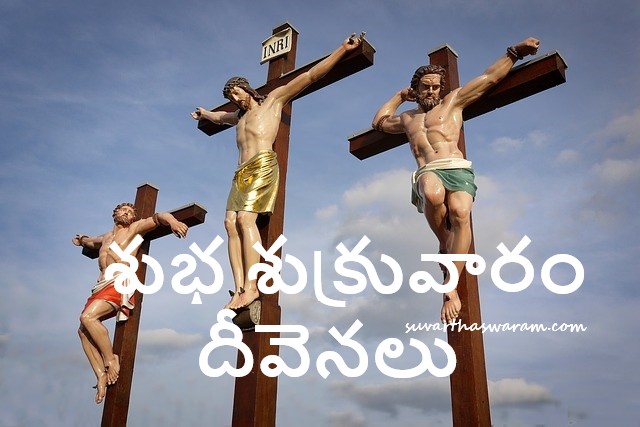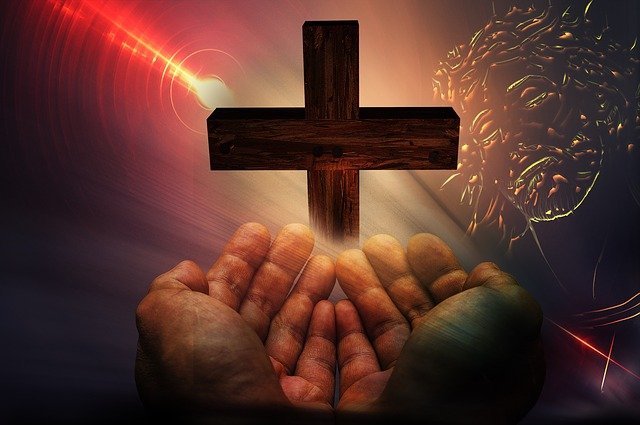యేసు క్రీస్తు సిలువలో పలికిన ఏడు మాటలు
మొదటి మాట :
తండ్రీ, వీరేమి చేయుచున్నారో వీరెరుగరు గనుక వీరిని క్షమించుము. (లూకా 23:34)
రెండవ మాట :
నేడు నీవు నాతోకూడ పరదైసులో ఉందువు (లూకా 23:43)
మూడవ మాట:
యేసు తన తల్లియు తాను ప్రేమించిన శిష్యుడును దగ్గర నిలుచుండుట చూచి అమ్మా,యిదిగో నీ కుమారుడు అని తన తల్లితో చెప్పెను, తరువాత శిష్యుని చూచి యిదిగో నీ తల్లి అని చెప్పెను. (యోహాను 19:26-27)
నాల్గవ మాట:
ఏలీ, ఏలీ, లామా సబక్తానీ, ఆ మాటకు నా దేవా, నా దేవా నన్నెందుకు చెయ్యి విడిచితివని అర్థము. (మత్తయి 27:46)
ఐదవ మాట:
దప్పిగొనుచున్నాను. (యోహాను 19:28)
ఆరవ మాట:
సమాప్తమైనది (యోహాను 19:30)
ఏడవ మాట:
తండ్రీ, నీ చేతికి నా ఆత్మను అప్పగించుకొనుచున్నాను (లూకా 23:46)
The seven sayings of Christ on Cross with references
“Father, forgive them, for they know not what they do.” — Luke 23:34
“Today shalt thou be with Me in paradise.” — Luke 23:43
“Woman, behold thy Son.” — John 19:26
“My God, my God, why hast Thou forsaken Me?” — Mark 15:34
“I thirst.” — John 19:28
“It is finished.” — John 19:30
“Father, into Thy hands I commend My spirit.” — Luke 23:46
Good Friday Pictures in Telugu






Good Friday Blessings




Good Friday Greetings

యేసు క్రీస్తు సిలువలో పలికిన ఏడు మాటలు
FATHER, FORGIVE THEM; FOR THEY KNOW NOT WHAT THEY DO.
యేసు క్రీస్తు సిలువలో పలికిన ఏడు మాటలు
మొదటి మాట :
తండ్రీ, వీరేమి చేయుచున్నారో వీరెరుగరు గనుక వీరిని క్షమించుము. (లూకా 23:34)
“Then said Jesus, Father, forgive them; for they know not what they do. And they parted his raiment, and cast lots” (Luke 23:34).
1. Having been falsely condemned, scourged, and crucified, He prayed for forgiveness for His enemies.
2. As He taught us to love enemies, He prayed for those who despitefully used Him (Matthew 5:43-48).
3. Though suffering wrongfully, our Lord Jesus Christ did not revile or threaten (I Peter 2:21-24; Is 53:7).
4. This prayer was (a) only for a few, (b) specific to one sin, and (c) based on human ignorance.
5. Rather than presuming eternal life for all present, let us match Stephen’s specific prayer (Acts 7:60).
6. And the Scripture was fulfilled, and he made intercession for the transgressors (Isaiah 53:12).
7. The mercy here sought and granted was only temporal for their abuse of Christ (Cp Acts 14:17).
8. Sin is aggravated by the degree of light in a person, and the soldiers had little (Lu 12:47-48; Jn 19:11).
9. Rejoice that such perfect righteousness was imputed to us in justification (Rom 4:6-8; II Cor 5:21).
10. The princes of this world did not know what they did; but we know things by His Spirit (I Cor 2:6-12).
1. They parted his raiment and cast lots for his woven coat (Matthew 27:35; Luke 23:34; John 19:23-24).
2. The Jews, rulers, soldiers, and thieves railed on him (Matt 27:39-44; Mark 15:29-32; Luke 23:35-37).

VERILY I SAY UNTO THEE, TO DAY SHALT THOU BE WITH ME IN PARADISE.
యేసు క్రీస్తు సిలువలో పలికిన రెండవ మాట :
నేడు నీవు నాతోకూడ పరదైసులో ఉందువు (లూకా 23:43)
“And he said unto Jesus, Lord, remember me when thou comest into thy kingdom. And Jesus said unto him,
Verily I say unto thee, To day shalt thou be with me in paradise” (Luke 23:42-43).
1. Both thieves had been railing against the Lord Jesus prior to these words (Matt 27:44; Mark 15:32).
2. But one thief began to defend Jesus and rebuke the other for his unjust accusations (Luke 23:39-41).
3. Men can only confess Jesus as Lord by the Holy Ghost (I Corinthians 12:3). Praise God for His grace!
4. This thief, by recognizing the kingdom of God, must have been born again to do so (John 3:3).
5. Therefore, we may conclude that Jesus Christ was speaking life even while dying (John 5:25).
6. Paradise is the third heaven (II Cor 12:1-7 cp Gen 1:6-8,14-19,20), where God and the angels dwell.
7. Both the elect thief and Jesus went to God’s Presence that very day, just as Paul taught (II Cor 5:6-8).
8. And we shall be instantly with the Lord in God’s Presence when we depart this body also.
9. Reject the New World Translation that moves the comma and teaches soul sleep from this passage, for the word “today” is modifying when the thief would be in Paradise rather than when Jesus spoke.

WOMAN, BEHOLD THY SON! BEHOLD THY MOTHER!
యేసు క్రీస్తు సిలువలో పలికిన మూడవ మాట:
యేసు తన తల్లియు తాను ప్రేమించిన శిష్యుడును దగ్గర నిలుచుండుట చూచి అమ్మా,యిదిగో నీ కుమారుడు అని తన తల్లితో చెప్పెను, తరువాత శిష్యుని చూచి యిదిగో నీ తల్లి అని చెప్పెను. (యోహాను 19:26-27)
“When Jesus therefore saw his mother, and the disciple standing by, whom he loved, he saith unto his mother,
Woman, behold thy son! Then saith he to the disciple, Behold thy mother! And from that hour that disciple
took her unto his own home” (John 19:26-27).
1. There was a particularly personal relationship between our Lord Jesus and John (John 13:23; 21:20).
2. The words addressed to Mary were not about Himself, but were directing her to consider John her son.
3. The words addressed to John were not about John’s mother, but were assigning Mary to John.
4. Even at death’s door, He showed obedience to God’s law with righteous zeal (Ex 20:12; I Tim 5:8).
5. He was lucid and strong enough to engage in wise mental preparation and cry out loudly several times.
6. Again, we should consider that such great righteousness was imputed to us by justification.
1. There was darkness over the earth from 12:00 P.M. to 3:00 P.M. (Matt 27:45; Mark 15:33; Lu 23:44).

MY GOD, MY GOD, WHY HAST THOU FORSAKEN ME?
యేసు క్రీస్తు సిలువలో పలికిన నాల్గవ మాట:
ఏలీ, ఏలీ, లామా సబక్తానీ, ఆ మాటకు నా దేవా, నా దేవా నన్నెందుకు చెయ్యి విడిచితివని అర్థము. (మత్తయి 27:46)
“And at the ninth hour Jesus cried with a loud voice, saying, Eloi, Eloi, lama sabachthani? which is, being interpreted, My God, my God, why hast thou forsaken me?” (Mark 15:34).
1. These words are found prophetically in Psalm 22:1; and they are found comparatively in Matt 27:46.
2. These words are recorded in Hebrew to explain the following confusion by some present (15:35-36).
3. “Well might the sun in darkness hide, and shut his glories in; when Christ the mighty Maker died.”
4. The comfort of God’s gracious Presence and affection for Jesus had been withdrawn due to our sins.
5. The degree of loneliness is determined by the degree of love, affection, and unity had beforehand.
6. The relationship between Jesus and His Father had been inviolate for His life (Isaiah 42:1; Matt 3:17;
11:27; 12:50; 17:5; 26:39,42,53; Luke 2:49,52; John 1:18; 5:17; 8:19,28; 10:17; 14:20; 15:10; 18:11).
7. We are afraid of the darkness and unknown, and Jesus had endured three hours of both in great agony.
8. The waves and billows of God’s wrath rolled over the exposed soul of the Lord Jesus (Psalm 69:1-3).
9. Sin sent the angels out of heaven, our parents out of Eden, and Jesus Christ from God’s Presence.
10. Separation from God’s Presence and enduring His Holy Wrath was given to Jesus (II Thess 1:9).

I THIRST
యేసు క్రీస్తు సిలువలో పలికిన ఐదవ మాట:
దప్పిగొనుచున్నాను. (యోహాను 19:28)
“After this, Jesus knowing that all things were now accomplished, that the scripture might be fulfilled, saith, I
thirst” (John 19:28).
1. The horrible thirst of our Lord Jesus Christ on the cross was prophesied (Psalm 22:15; 69:21).
2. The bodily suffering of Jesus was very real; we cannot forget His humanity and physical experiences.
1. They gave Him a spunge with vinegar on a reed to His mouth (Matthew 27:48; John 19:29).

IT IS FINISHED
యేసు క్రీస్తు సిలువలో పలికిన ఆరవ మాట:
సమాప్తమైనది (యోహాను 19:30)
“When Jesus therefore had received the vinegar, he said, It is finished: and he bowed his head, and gave up the ghost” (John 19:30).
1. What was finished? The work He was sent to do was finished (Matthew 1:21; John 6:39; 17:1-3).
2. Who will require more in the work of redemption, if the Son of God declared it finished (Ro 8:33-34)?
3. Who will require further offering and perfection, if our Lord Jesus perfected us forever (He 10:10-14)?
4. If you are too simple to remember detailed arguments for the truth of salvation, remember these words.

FATHER, INTO THY HANDS I COMMEND MY SPIRIT
యేసు క్రీస్తు సిలువలో పలికిన ఏడవ మాట:
తండ్రీ, నీ చేతికి నా ఆత్మను అప్పగించుకొనుచున్నాను (లూకా 23:46)
“And when Jesus had cried with a loud voice, he said, Father, into thy hands I commend my spirit: and having
said thus, he gave up the ghost” (Luke 23:46).
1. He laid down His life; it was not taken from Him only (John 10:18).
2. He died prematurely; there was surprise He was already dead, for crucifixion kills slowly (Mk 15:44).
3. Though forsaken in God’s consolatory comfort and fellowship, He chose to enter the veil of death with
confidence and faith in the hands of the Most High. It shall not be so severe for faithful saints.
4. Let us consider such great faith and trust in God (Matt 27:43; Hebrews 2:13 cp 11:6; Gal 2:16).

